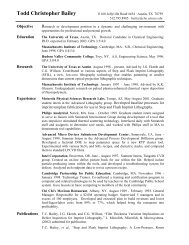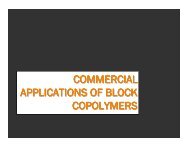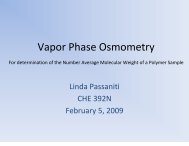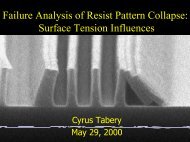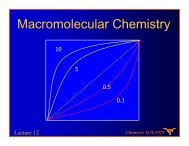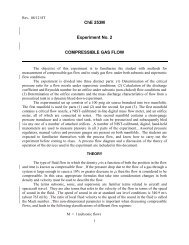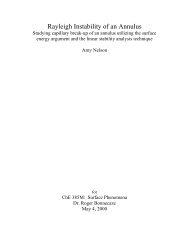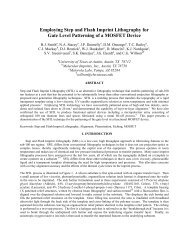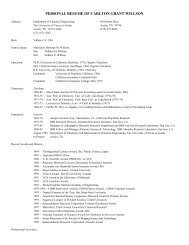Asymmetric fluid-structure dynamics in nanoscale imprint lithography
Asymmetric fluid-structure dynamics in nanoscale imprint lithography
Asymmetric fluid-structure dynamics in nanoscale imprint lithography
- No tags were found...
Create successful ePaper yourself
Turn your PDF publications into a flip-book with our unique Google optimized e-Paper software.
orientation stages relative to the substrate is with<strong>in</strong> the range of motion for thetemplate orientation stage to self-correct dur<strong>in</strong>g the fill<strong>in</strong>g and squeez<strong>in</strong>g process.In the multi-impr<strong>in</strong>t stepper, there are no means to determ<strong>in</strong>e if the template andsubstrate are parallel dur<strong>in</strong>g the impr<strong>in</strong>t process, orientation correction is basedondesign of flexures that self-correct dur<strong>in</strong>g the squeez<strong>in</strong>g process. Base layerthickness is determ<strong>in</strong>ed experimentally for various load<strong>in</strong>g conditions andcontrolled by mov<strong>in</strong>g the template towards the wafer until a specified load ismeasured, which corresponds to the desired base layer thickness.The template orientation stages are passively, selectively compliant.These flexure stages have been implemented to m<strong>in</strong>imize angular misalignmentbetween the template and wafer. The flexure stages provide the advantage ofhav<strong>in</strong>g repeatable l<strong>in</strong>ear response through small displacements without generat<strong>in</strong>gparticles. However, a problem with thick, wedge-shaped base layers rema<strong>in</strong>s as amajor challenge to SFIL research. Furthermore, the current process reliesheavily on force sens<strong>in</strong>g to determ<strong>in</strong>e the film thickness dur<strong>in</strong>g the fill<strong>in</strong>g andsqueez<strong>in</strong>g process. There is not enough correlative data to determ<strong>in</strong>e absolutegap thickness and orientation <strong>in</strong>formation from force measurements. Therefore, itis highly desirable to be able to characterize the absolute base layer thickness <strong>in</strong>real-time. An active stage design may be necessary to <strong>in</strong>vestigate solutions tothese challenges.3.2 ACTIVE STAGE COMPONENTSTo achieve a repeatable, uniform base layer thickness <strong>in</strong> the range of 100to 200 nm, it may be necessary to have an active stage to provide precise controlover the base layer thickness as well as orientation alignment between the42



